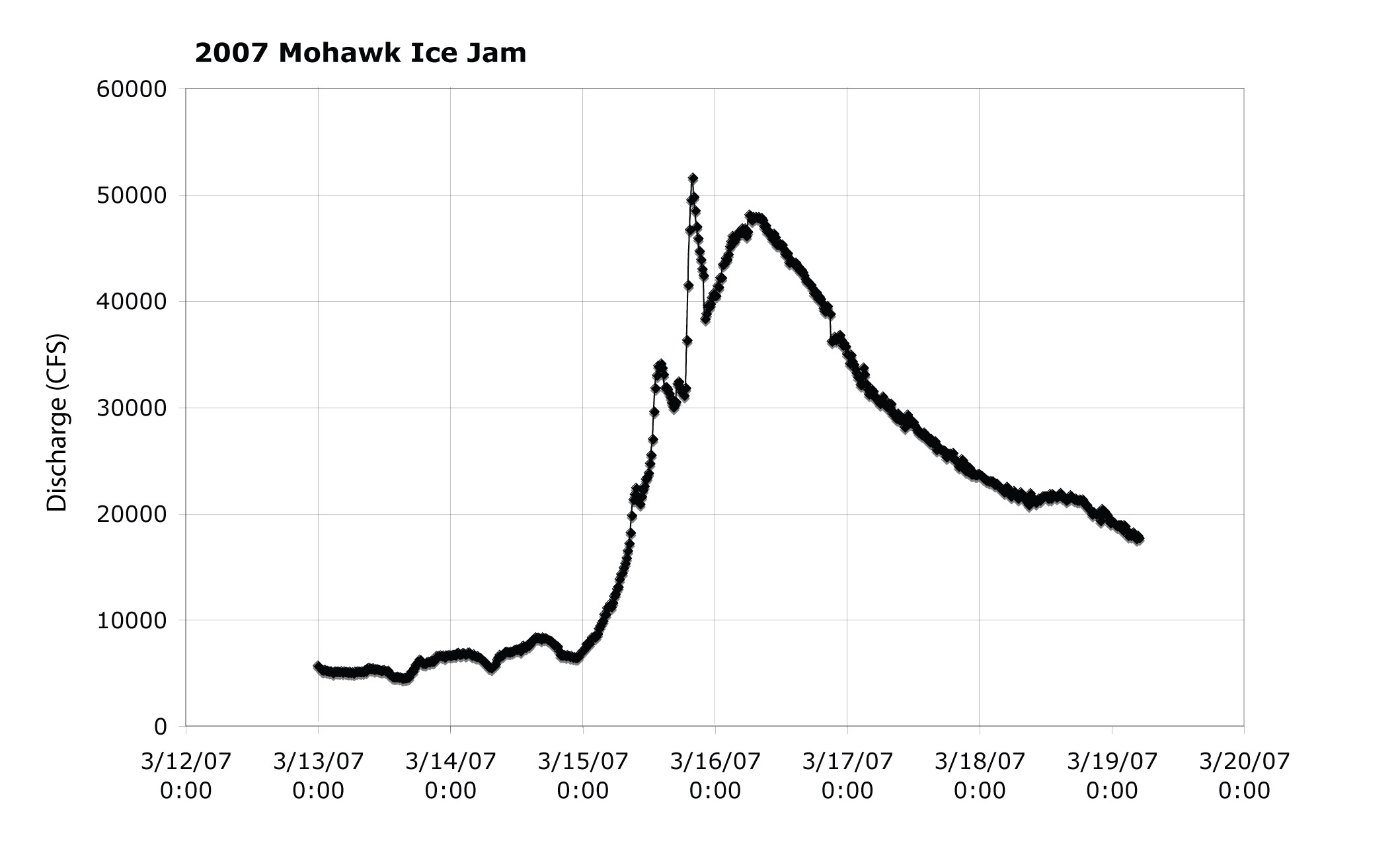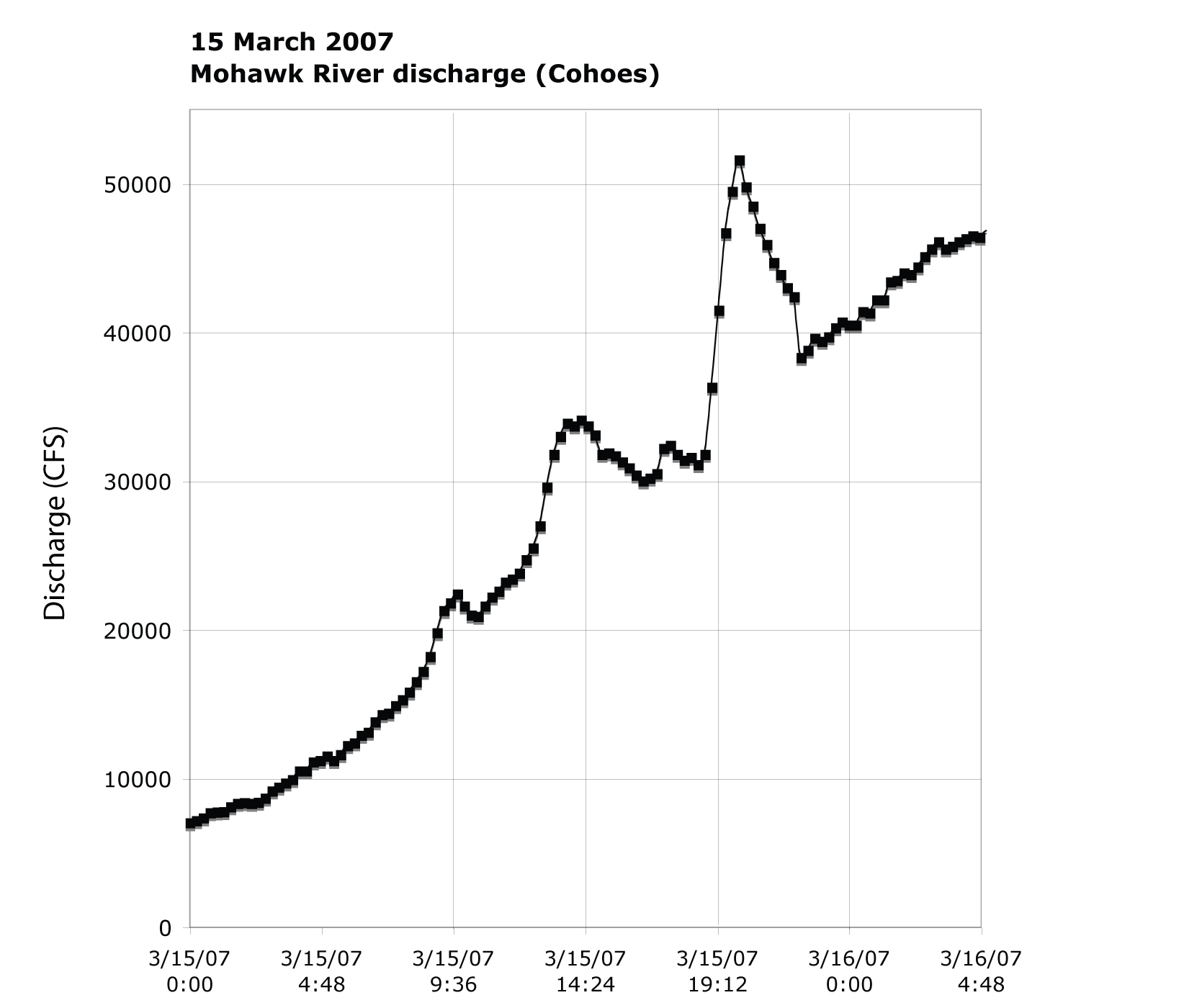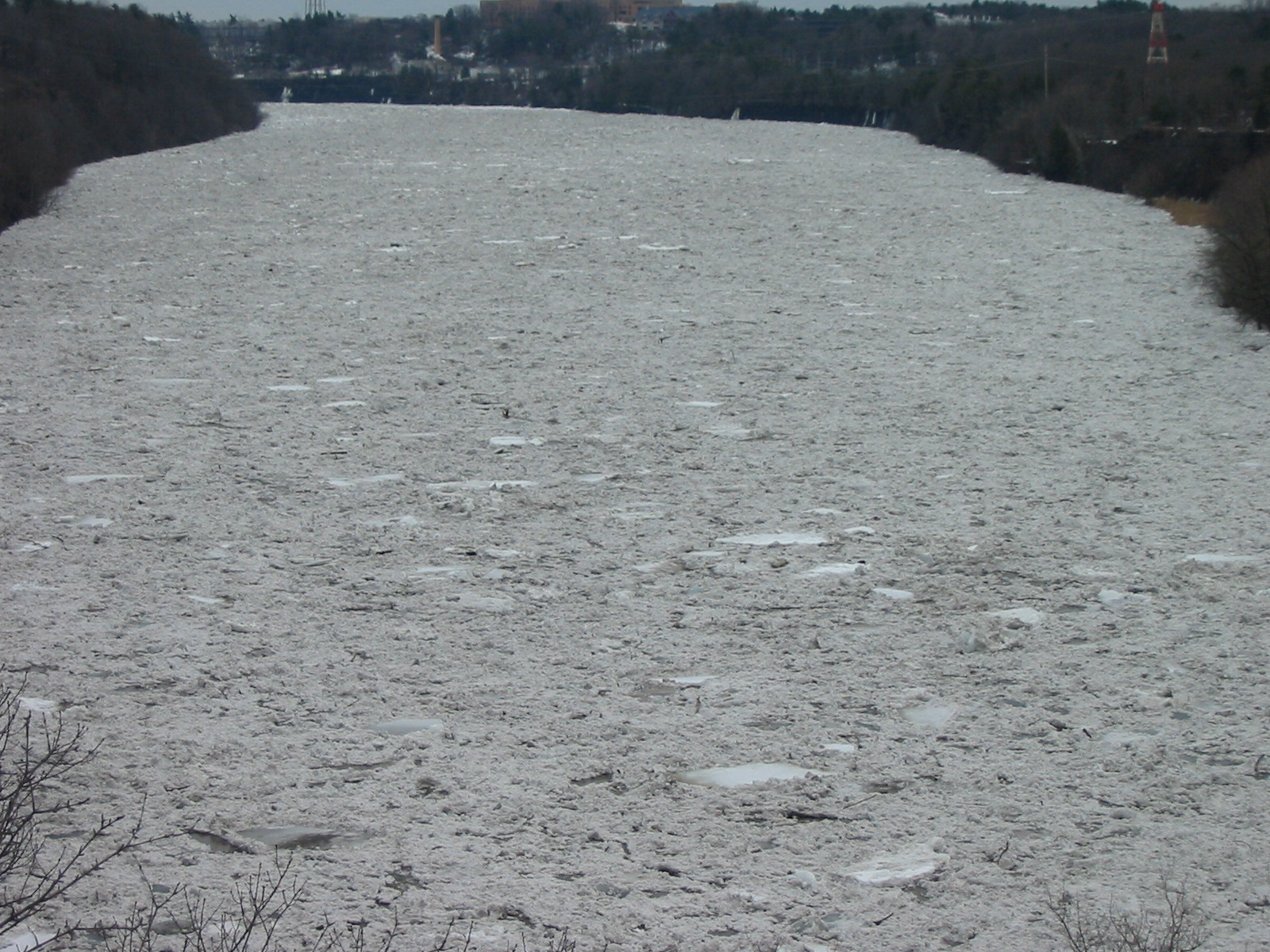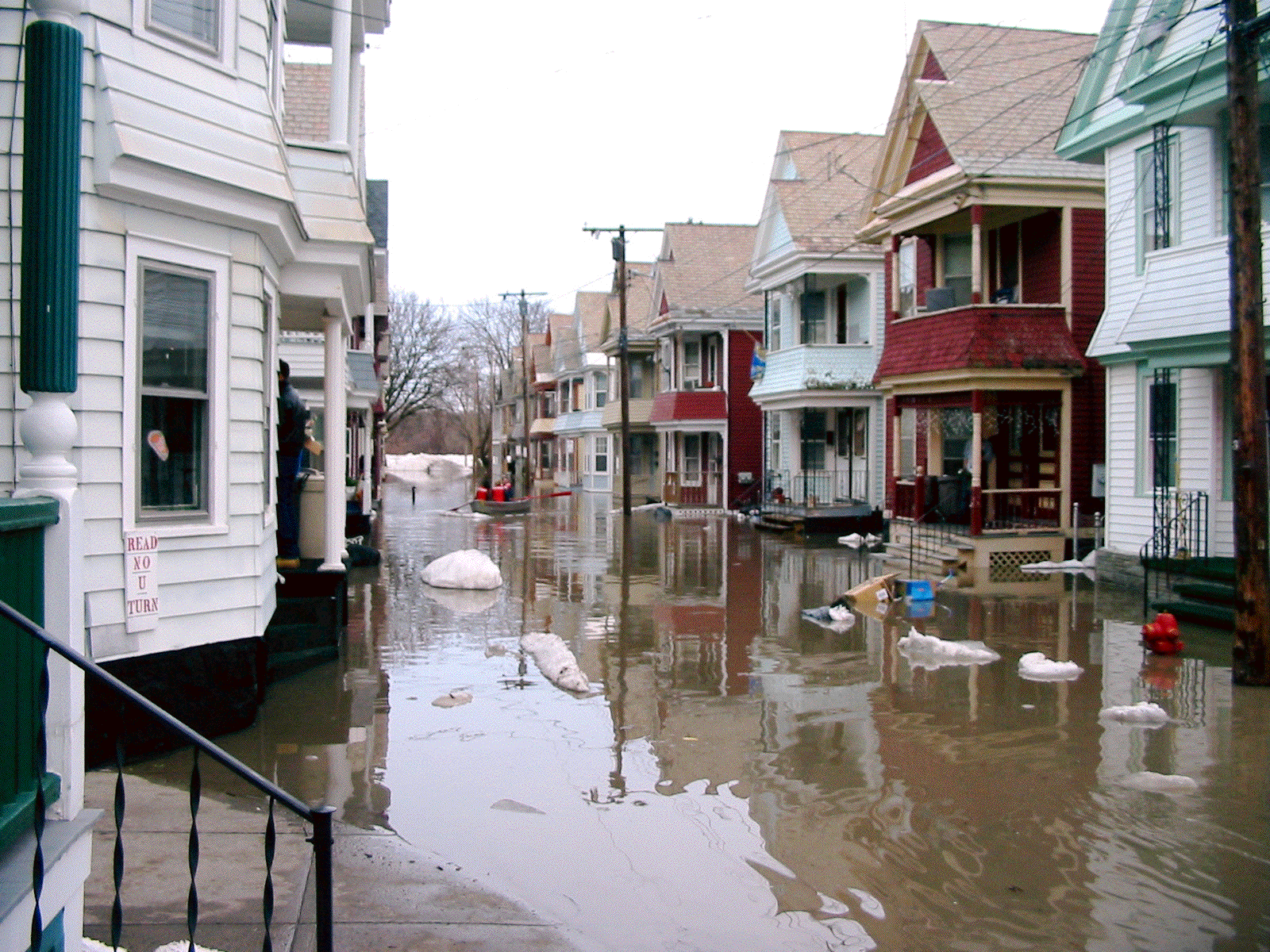This
is a brief summary of the main features of the March 15 ice jam that occurred
in the Mohawk River in Schenectady and Saratoga Counties. The ice floes that worked their way
through Schenectady were loosened by warming weather that melted a
considerable snow pack and relatively well-formed ice cover. This was a moderate ice jam that
produced significant flooding in the Stockade district of Schenectady. At the
time of maximum backup (maximum stage elevation) in Schenectady, houses in
lower areas were evacuated, power was cut, and a state of emergency was
declared.

Figure
1: Map showing the approximate location of the ice jam that resulted in backed
up water and flooding in the Stockade of Schenectady. The front of the ice jam is estimated but is probably
within 1 km of its position. The
ice jam was approximately 5-6 miles long. Note that the Cohoes station is about 19 miles downstream from the
Stockade district of Schenectady.

Figure
2: Discharge measurements for 15-minute intervals for the entire event between
centered on 13 to 19 March, 2007. This hydrograph represents the un-corrected values of calculated
discharge (Q in cubic feet per second) at the USGS gaging station at
Cohoes. Note that two sets of ice
jams occurred in this event. The
first one was relatively small and the collected ice was centered in
Schenectady. This first Jam was in
place by 0900 15 March. A large
floe of ice seen in the morning upstream of Lock 9 then joined the first floe
in the afternoon, and that caused the major jam that characterized this
event. Note that freezing
temperatures and snowfall slowed the melting by Friday midday, and very little
thawing occurred after the initial pulse that was related to breakup.

Figure 3: Discharge for ice jam interval, which shows
Peak flow of 51,600 cfs that occurred at 8:00 pm (2000) on 15 March, 2007, this
was a dramatic increase from 31,100 at 6:45 PM (1830) just one hour and fifteen
minutes before. These data suggest
that the main jam had a lifespan from about 1:45 PM to 6:45 PM or about 5
hours. This lifespan is estimated
from the prominent lull in the hydrograph between these intervals, which
corresponds to a period of decreased flow on what was the rising limb of the
hydrograph.

Figure 4: Photograph of the leading edge of the ice jam in the
Rexford Knolls looking east towards GE R&D and Knolls. Front of the ice floe is just around
corner and it occurred in a location that is typical for ice floes to get
jammed. This is an unusual part of
the Mohawk channel because it is entirely incised into bedrock (here sandstone
and shale of the Ordovician Schenectady Formation). Photograph was taken at approximately 530 PM, 15 March
2007. This ice floe extended
upstream to the Stockade district of Schenectady. (Photo: JI Garver, Geology, Union College).

Figure 5: Photograph
of the Ingersoll Ave in the Stockade district of Schenectady (NY). This picture was taken at about
6:45 (1845), almost exactly at the time of the highest stage elevation in
Schenectady, which was 226.5 feet (Photo: JI Garver, Geology, Union College).
DISCUSSION
The 15 March 2007 flooding in the Stockade was entirely related to
ice jamming downstream from the city of Schenectady. During this event, discharge in the Schenectady reach of the
Mohawk River probably never surpassed 45,000 to 50,000 cfs, which makes this an
insignificant event with respect to expected high water. However, the formation of the ice jam
and the resulting backup of water was entirely responsible for the inundation that
occurred in the Stockade. This
reinforces earlier findings that the key component in these events is the
evolution of stage elevation, which is not clearly related to discharge. Note that typical flood plain maps are
based on 100, and 500 yr expected elevations inferred from discharge. This last point is worth emphasizing
because it is counter intuitive. In virtually all river floods discharge
(total volume of water per unit of time typically measured in cubic feet per
second) is almost directly related to the Stage elevation (height of water). The relationship is not always linear
because there are variations in flow rate, channel shape, etc. Ice jam flooding can, and should be
viewed as a different phenomenon. While it takes warm weather and high water to cause break up, the stage
elevation quickly becomes decoupled once the ice jams form. When this occurs, the only effective
means of observation that can lead to effective mitigation is a clear
understanding of the position of the ice jam, and how stage elevations change
behind the ice jam. The back up of
water behind the 15 March 2007 ice jam is here estimated to have been 13 feet,
but it is clear that it might easily have been higher given the cool weather and
low-flow conditions.
Breakage of the ice dam at about 6:45 PM resulted in a downstream
rush of water well recorded at the USGS gaging station at Cohoes. Soon after
the breakup of the jam, there was a surge of water that spread quickly
downstream. Nominally this surge
was an additional 20,000 cfs. This
outburst is inferred to have flowed through Cohoes (about 15 miles downstream
from the front of the jam) between 7 and 8 PM on Thursday 15 March. Because the Schenectady County
Emergency Management team noted a significant drop in the Schenectady pool at
this time it is clear that this surge of water measured at Cohoes was related
to the breakup of the dam that occurred in the Rexford Knolls just upstream
from Lock 7. The peak discharge at
Cohoes occurred at 8:00 PM and then total discharge was 51.6k cfs (cubic feet
per second).
This ice jam formed in the Rexford knolls, a bedrock-incised part
of the Mohawk channel that is distinct and unique. This is a common jam point for ice floes, presumably because
it is narrow and confined and there is no floodplain that allows the water to
spread out. Our research shows
that over the several hundred years, it is typical for ice jams to form on the
Mohawk between the Old Burr Bridge abutments and the Rexford Knolls - the most
common jam points on this entire stretch of the Mohawk (basically between
Schenectady and Lock 7). As such,
these ice jams pose a unique and serious hazard for the city of Schenectady
(and to a lesser extent Scotia). We’d
note that this part of the river channel is unique because it lacks a
floodplain and because it is bedrock bound.
This part of the Mohawk is relatively young having captured
the main flow from the Paleo-Mohawk at about 10 Ka. Prior to this time, it is inferred that the Mohawk flowed
north up the Alplaus and through what is now an abandoned channel occupied by
Ballston Lake and adjacent lowlands in the paleo-channel. Although this is ancient history in the
evolution of a river, it is relevant here because it provides a framework as to
why this part of the Mohawk River has such a special hazard. Since capture and readjustment of the
course of the Mohawk, the river has had to rapidly incise into the bedrock high
that now forms the Rexford knolls. Even since settlement, this stretch of the river has been treacherous,
and today we see that large ice floes have trouble getting through this narrow
incised part of the channel. This
is a natural feature, there is nothing we can do to mitigate the effects of
this narrow channel.
This 15 March 2007 ice jam was not an unusual event. The timing, size, magnitude, and
duration were typical for ice jams on the Mohawk during spring break up. It is important to note that during
spring breakup floods the ice can get washed though the system when breakup is
accompanied by relatively high discharge that crests well after major ice floes
move through the system. However,
in cases where breakup occurs during relatively low flow conditions, like the
2007 event, there is a danger that the floes will not get washed through and
will instead get trapped and frozen in place. These situations have the
potential for serious ice damming that can cause rather large run ups of water
behind the dam. In this case, the
run up is here estimated to be 13 feet, but it is entirely possible that this
run up could be in excess of 20-25 feet. In this scenario, a stage elevation of 233 feet or greater would be
possible in the Stockade.
This sort of extreme event (+20-25 feet) was entirely possible on
15 March 2007. In this case,
an extremely rapid rise in the river level would have given emergency managers
very little time for evacuation. On 15 March, the river level (stage) rose at approximately 1 foot per
hour (Van Hoesen, personal Communication). If a sudden jam/dam occurred during
this event that further prevented water from passing under the floe, it is
possible that the rate of rise would be 2 to 4 feet per hour.
One of the most frustrating aspects of this event, and all others,
is the lack of real time data available for analysis while the event
transpires. Emergency management
relies on first hand observations that are difficult to impossible to
synthesize in a meaningful way. In
fact, it is clear that if major stoppage of the water were to occur, it would
only be recognized once it was too late to attempt further evacuations.
Schenectady County sould consider installing a series of four or five
real-time pressure transducers capable of reading instantaneous stage
elevations along this critical reach of the Mohawk River (see Appendix A).
APPENDIX A: Possible locations for real-time river elevation
monitors.

Real time pressure transducers measure the height of water
and ice above them. They are
simple devices that can provide instantaneous data to a computer, and then the
data can be transmitted by the internet. Ideal locations would be below and above the most common points for ice
jamming on the Mohawk. These
possible locations include (right to left): Lock 7 power station, Mohawk
Marina, Stockade (Union Boathouse), Lock 8.
APPENDIX B: Weather surrounding this event (modified from
www.cbs6albany.com)
Date
|
High
|
Low
|
Rain
|
Snow
|
Weather
|
Sunday,
3/11/2007
|
41
|
26
|
0.01"
|
0.0"
|
Cloudy,
light rain and fog, a gusty WNW breeze 15-25 mph, peak gust @ Albany of 30
mph
|
Monday,3/12/2007
|
48
|
23
|
0.00"
|
0.0"
|
Bright
sunshine in morning,increasing cloudiness through the afternoon and evening,
mild and dry
|
Tuesday,3/13/2007
|
55
|
28
|
0.00"
|
0.0"
|
Sunshine
mixed with cloudy periods, a few light showers otherwise dry, a light to
moderate southerly breeze, mild
|
Wednesday,3/14/2007
|
65
|
46*
|
0.02"
|
0.0"
|
Record
high minimum temperature set, hazy sunshine mixed with mid and high clouds
during the morning with temperatures soaring, low to mid 70s. Overcast
developed in afternoon, rain moved into the Capital Region from the west
after 3pm ending in most areas by 8pm, areas of dense fog during the evening
and nighttime hours with patchy drizzle and a few additional showers through
midnight
|
Thurs,3/15/2007
|
55
|
27
|
0.53"
|
0.0"
|
The
high temperature occurred at 1:25am, the daytime high temperature was 46°,
the low temperature for the day of 27° occurred at 11:59 pm, rain and fog
through the morning and early afternoon, rain was moderate to heavy at times,
tapering off and ending in all but Ulster, Dutchess, Berkshire, and
Litchfield Counties by the late afternoon and the evening, rainfall amounts
ranged from 1/4" to 3/4" on average, rain changed to snow in the
higher elevations of Otsego, Delaware, and Schoharie counties during the late
morning and early afternoon before ending, trace to 1/4" amounts,
gradually falling temperatures through the day
|
Friday,3/16/2007
|
27
|
20
|
0.51
|
10.3"
|
Major
Nor'easter: cloudy but generally dry through the morning…heavy snow, rates of
1"-3" per hour, in the Catskills by the late afternoon and into the
night, ..snowfall amounts by 11pm ranged from 3"-6" in the
Adirondacks, Mohawk valley. NNE winds ranged from 15-25 mph and produced
widespread blowing and drifting of the fine light snow, temperatures ranged
from the upper 10s through the low 20s
|
Saturday,
3/17/2007
|
28
|
21
|
0.19"
|
2.9"
|
Major Nor'easter Continued: heavy snow continued, rates of
1"-3" per hour through the pre-dawn hours, sleet in areas east and
south of Albany, steadiest and heaviest snow ended by 7am with widespread
10"-18" 7"-10" in the western Adirondacks and Mohawk
Valley, with a bullseye of 18"-24" in parts of Columbia &
Dutchess Counties,
|
|






